Artistic and intricate architecture is seen all throughout the world, varying throughout the four nations. Every country uses different materials to construct buildings, such as metal, stone, and ice, depending on the specific climate of each nation and locally available equipment, in addition to the inheritance and cultural traditions of each region. Palaces, temples, houses, and small huts are examples of architectural work.[1]
Air Nomads[]
Air Nomads believed in peace and harmony in the world, which was positively reflected in their architecture. The earliest ancestors of the Air Nomads did not want to leave any sort of footprint on the Earth and had no truly permanent dwellings. They lived in huts made out of grassy, woven material, and cultivated gardens nearby. Although they maintained a nomadic lifestyle, they later built the air temple as permanent stone structures.[2]

The recently restored Southern Air Temple has a large tower and is the only temple with blue roofs.
The air temples were generally comprised of towers and pagodas arranged on a tall mountain, or in the case of the Western Air Temple, hanging from a cliff.[3] Air Nomad roofs were made from ceramic tiles painted green, with the exception of the Southern Air Temple.[4] All of them, especially the Western Air Temple, were considered architectural marvels to the other nations, being built on high mountains or even upside down.[5]
List of architectural works[]
- Air Nomad statues - In each of the air temples, there are statues of respected Air Nomad elders who once lived there.
- Eastern Air Temple - The Eastern Air Temple's towers are built over three mountains, connected by elegant arch-like bridges. The temple also features a flying bison stable.[6]
- Northern Air Temple - Built on a mountain like the Southern and Eastern temples,[7] the Northern Air Temple also had a number of towers and characteristic green roofs, but was destroyed by Ghazan in 171 AG.[8]
- Southern Air Temple - The Southern Air Temple has large towers and is the only temple with blue roofs. Statues of each Avatar can be found in a dedicated sanctuary,[4] a trait shared with the Northern Air Temple prior to its destruction.
- Stupas - A mound-like structure which has the eyes and tattoos of an airbender painted onto the side.[9]
- Western Air Temple - This temple is located in the mountains north of the Fire Nation. Its design allows wind to flow into even the deepest chambers, which made the Air Nomads feel quite at home.[3]
Water Tribe[]

The Northern Water Tribe Royal Palace showcases typical Northern ice architecture.
The architecture of the Water Tribe is starkly different compared to that of the other three nations. In the Southern Water Tribe, houses are supported by wooden branches with animal skins to cover them,[10] while in Agna Qel'a, most constructions are made of ice,[4][11] including buildings, bridges, and sculptures, and the structural supports were fashioned from whale bones,[12] although the Northern Water Tribe's outlying villages appear similar to those in the south.[13] Following the Southern Reconstruction Project, the Southern Tribe's capital was greatly expanded and its building methods were improved, implementing larger constructions made of ice and snow like its sister tribe.[14][15] In the Foggy Swamp, people live in small huts supported a few feet above ground to protect them from flooding.[16]
A qarmaq is a type of dwelling built by the Water Tribe that can be found outside their homeland. There are several old qarmat in Port Tuugaq on Shimsom Big Island.[17]
List of architectural works[]
- Layout of Agna Qel'a - Agna Qel'a is made entirely of ice. It is divided into two areas ‐ an outer area primarily for defense, and an inner area which consists of the main city and the Spirit Oasis. A very tall and wide wall, also made of ice, defends the city from naval attacks. There are also water canals and pathways throughout the entire settlement.[18]
- Northern Water Tribe Royal Palace - A building used to house the tribal chief and his family. This is also the place where the chief and his advisers sit and make decisions regarding the Tribe. It features a dining hall, several bedrooms, a courtyard, and a throne room.
- Southern Water Tribe compound - An isolated encampment secured by thick ice walls and a large gate. The enclosure features several watchtowers, large buildings for shelter, an obstacle course, and sub-level pens.[14]
- Southern Water Tribe prison - A building in the high ranges of the Southern Water Tribe used to house Water Tribe prisoners. It features several watch towers, a courtyard, and a whole corridor of prison cells.
- Southern Water Tribe Royal Palace - A building built after the Hundred Year War to house the Head Chieftain.[15] It features a banquet room, which can also be used as a court, a throne room, and a meeting room, used by Unalaq to discuss what action to take with the Southern Water Tribe rebels.
- Spirit Oasis - Built with perfect symmetry, the Spirit Oasis was noted for its tranquil, warm and green look and feel. This is the place where the spirits Tui and La, the Ocean and Moon Spirits, reside.[19]
- Water Tribe Avatar Temple - The Water Tribe Avatar Temple, made out of ice, features a diamond-shaped figure at its peak that shines brightly when the Avatar enters the Avatar State.
- White Lotus prisons - Specifically designed to negate the abilities of its respective prisoner, the White Lotus prisons are four maximum security facilities scattered in isolated regions throughout the world, constructed specifically to detain Ghazan, Ming-Hua, P'Li, and Zaheer.
Earth Kingdom[]

The Earth Kingdom Royal Palace is built with a combination of wood and stone, like most inner-city buildings.
The Earth Kingdom, with its immense size and diversity, has a variety of building methods and designs, ranging from simple farmhouses to vast palace complexes.
Building methods and designs in rural areas of the Earth Kingdom are generally simple; houses and halls are generally built using wood, roofs are unpainted and have eaves, and walls are made from thin wood.
More elaborate, sophisticated materials and designs are utilized in more developed areas; in large cities such as Omashu and Ba Sing Se, for example, buildings are constructed with a combination of wood and stone, with tiled roofs. A large number of buildings, especially the larger ones, are often constructed by earthbenders, who can typically finish the majority of the work in a fraction of the time it would take with more standard methods. Abandoned quarries surrounding the capital supply the Middle and the Upper Ring of Ba Sing Se. The marker of wealth for most Earth Kingdom citizens is whether their house is built with stone from the ground below it. The farther the rock has to travel, the fancier it is.[20]
Due to the large open spaces in the Earth Kingdom, buildings and estates tend to be more spread out over a larger area than in other nations and tend to have a smaller percentage of high-rise buildings than the Fire Nation or the Air Nomads.[1]
Most cities in the Earth Kingdom were square and four-sided, though when settlements were forced into circular plots of land, they often arranged themselves in rings to mimic Ba Sing Se, with the layout making it easy to divide the rich and the poor.[21]
The Earth Kingdom possesses residences with an old traditional siheyuan design that dates back to the Hao line of Earth Kings, which consists of large and fortified complexes often owned by wealthy citizens.[22]
List of architectural works[]
- Beifong Estate - The Beifong Estate, located in the midst of a great garden, is a large home owned by the Beifong family, one of the richest families in the southern Earth Kingdom.[23]
- Earth Kingdom Avatar Temple - The Earth Kingdom Avatar Temple is hidden away in a high mountain range. The colossal stone temple can only be reached by a series of hundreds of steps. It features a painting of several Avatars, the eyes of which glow when an Avatar enters the Avatar State.[4]
- Earth Kingdom Royal Palace - The palace is contained within a vast circular compound that is walled. The palace is comparable more to a city in terms of size rather than a mere palace. It is structured around a meridian line that cuts through the center of the city, from West to East, and leads directly to the Earth Monarch's throne. The Royal Palace itself is a tiered compound of towers, gardens, pavilions, shrines, and courts that has been the home of the Earth Kings since the city's foundation.[24]
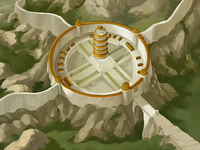
General Fong's fortress is built like a small city.
- General Fong's fortress - Located in the western Earth Kingdom, the fortress was one of the few remaining strongholds for the country in the region during the Hundred Year War and was built like a small city. It has barracks for the troops, guest quarters, a large infirmary to care for injured soldiers, a war room, a temple to pray, and a recreation area for soldiers to relax.[25]
- Layout of Ba Sing Se - The capital of the Earth Kingdom is closer in size to a small country than a city, and its years of isolation have given it a distinct architectural style slightly different from many other towns. The layout of the city is divided into three rings distinguishing class: the Lower, Middle, and Upper Rings. The majority of the buildings are made of stone, with wood supports and plaster covering the outside. The color of roofing tiles on buildings indicate their prestige and vary by ring. While most of Lower Ring buildings have black or dark green tiles, Middle Ring buildings have vibrant green, and Upper Ring nobility use golden tiles as a sign of class. Earth Kingdom symbols are often placed on gates, government buildings, and military sites. Roads in the Middle and Upper Rings are made of flagstones, while the Lower Ring has muddy dirt paths for most of its streets and alleys.[24]
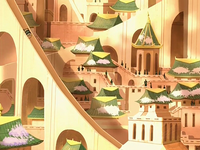
Omashu is made up of many tiered levels built into the hillsides.
- Layout of Omashu - Omashu is built on a cluster of steep hills raised by Oma, one of the first human earthbenders. The palace sits on the tallest hill, which is in the center behind others, towering over a deep chasm. It has a complex mail system, which consists of a series of interconnected tunnels underneath the city used to transport water and sewage. Omashu's three gates are composed from massive stones, each five feet thick and towering over thirty feet high. As a result, the gates can only be opened by skilled earthbenders who guard the single entrance. Buildings in Omashu are generally built from stone and have green tiled roofs. The entire city was designed so that it runs on earthbending.[26]
- Misty Palms Inn - An inn located in the Misty Palms Oasis. This was the place where Korra and Team Avatar stayed during their time in the Misty Palms Oasis. There are several rooms, a swimming pool, and many stores nearby to accommodate their guests.
- Walls of Ba Sing Se - The walls of Ba Sing Se are the highest, thickest and strongest walls in the world. The Outer Wall in particular is six hundred feet tall[27] and features large guard tower complexes build inside the wall itself. The Outer Wall is also supplied with large boulders for defense.[28]
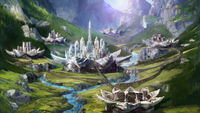
Zaofu was the first settlement constructed entirely out of metal.
- Zaofu - The city of Zaofu was founded and constructed by Suyin Beifong, and is comprised entirely out of metal. It consists of several metal buildings separated from one another, with the different areas interconnected via metal rails which allow individuals to reach opposing ends of the city limits in very little time. The development of the city incorporates a number of innovative designs, in particular the large, petal-like metal panels that surround each portion of the settlement, which remain open during the day but close to provide protection at night. Buildings within each section range from small edifices to large skyscrapers, and a large metal statue of Toph Beifong stands in the middle of the downtown core. At the edge of the city is Suyin's estate, a large metal compound consisting of numerous halls and courtyards. Near the estate are several guesthouses for individuals which Suyin chooses to receive.
Fire Nation[]
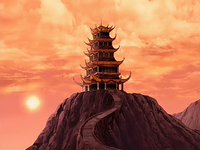
The Fire Nation Avatar Temple was built more vertically than horizontally, as are many Fire Nation buildings.
The Fire Nation is less diverse and more centralized than the Earth Kingdom. Having significant technological development, most cities have an industrial sector.
Building methods and designs in the Fire Nation are on average more elaborate than most areas of the Earth Kingdom. Houses and halls are generally built using wood and stone. However, in poorer areas, stone buildings are less common in the Fire Nation than the Earth Kingdom, due to the absence of earthbenders.[21] Roofs are painted with warm colors, with red being most common, though gold is also a popular color in the nation's architecture. Many of these iconic designs were inspired by the architecture of a civilization predating the Fire Nation, known as the Sun Warriors.
The Fire Nation has a tendency for building vertically as much as possible, often concentrating its status like a point of a spear with high towers.[29] This is more and more evident in the inner islands, where the amount of stable, even land on which to build is limited by the uneven volcanic landscape.[1] In poorer towns such as Fire Fountain City, the settlement is built in wedges, with houses and markets angling toward the center, separated by streets resembling the spokes of a wheel.[21]
List of architectural works[]
Fire Nation proper[]
- Boiling Rock - This massive Fire Nation prison is located in a boiling lake, making it impossible to escape by swimming as one would be severely burnt, if not outright boiled alive. Its walls are made out of an extremely thick and most indestructible metal available, and the only access to the outside world is via a gondola over the lake.[30][31]
- Coronation Plaza - The Coronation Plaza, where Fire Lords are crowned, is a symmetrically built plaza with large structures on both ends. A series of steps at the front end lead up to the building from where the new Fire Lord would emerge just before the crowning.[32]
- Dragonbone Catacombs - Located underneath the Fire Sages' temple in Capital City, these catacombs hold many rooms and many secrets about Fire Nation history, as well as skulls and bones of dead dragons.[33]
- Fire Nation Avatar Temple - The Fire Temple, a five-tiered pagoda, sat on a hill near the volcano's base on Crescent Island and was managed by the Fire Sages[4] before its destruction by the spirit of Roku in 99 AG.[34] Part of the temple was created by bending lava into tunnels. This was the only piece of architecture known to be constructed with bending in the Fire Nation.

The Fire Nation Royal Palace is a single structure.
- Fire Nation Royal Palace - An elaborate tower with triple eaves is at the center, with three distinct wings joining it. The two smaller wings stand on either side of the main entrance to the palace building with other towers at the ends of them. Directly opposite of the main entrance is the third, larger wing, which houses the Fire Lord's Throne Room. Inside, the palace is comprised of enormous high-ceilinged halls and retains an intricate array of wings and chambers. Large tapestries line the walls and elaborate fire-themed images and moldings are laid out all throughout the numerous sections of the structure.[35]
- Layout and defenses of Fire Nation Capital - The city is one of the larger cities in the four nations. It has a distinct layout, consisting of a harbor surrounded by a dock and the Royal Plaza, an industrial Harbor City behind the Plaza, and finally Hari Bulkan, a neighborhood in the crater of a dormant volcano where Fire Nation elite live around the Royal Palace. The city has extensive defense works and is heavily fortified. Due to the limited space in caldera and the growing number of nobles as the Fire Nation gains ever-more territory, mansions and buildings have steadily been rebuild higher and higher, in an attempt to get as much floor space out of as little land as architecturally possible. A number of homes are being built further and further up the rocky crags that line the crater.[36] Fire Nation commoners are not allowed to enter the city unless they receive an invitation from the Fire Lord, which are rarely issued.[37]
Sun Warriors[]
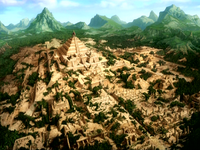
In the Sun Warriors' ancient city remains a small population of Sun Warriors.
- Sun Warriors' ancient city - Much of this stone metropolis is now covered in vines and sits unused. This is because the tribe is much smaller than it used to be. Some of the architecture of this ancient city is mirrored in today's Fire Nation architecture, including the Fire Sages' temples.[38]
Colonies[]
- Fire Nation colonial village- This town's architecture was similar to that of the Fire Nation, as there many pagoda styled buildings located within the town. There are also plenty of lamps to illuminate the city at night, extravagant arches, and wooden homes and buildings inside the wooden outer wall, though the wooden homes are all identical to each other, with one door facing the main street, yellow sides and blue rooftops, and they also sported many decorations.
- New Ozai - New Ozai's architecture was far different than that of the Fire Nation as a result of building over existing Earth Kingdom architecture. It had developed extensive metal bridges to overcome the gorge to allow incoming building supplies greater access than the single stone road at the city's main gate. Omashu's palace was leveled and replaced by a metal pagoda more favored by the Fire Nation. Most of the ordinary buildings were commandeered by the Fire Nation and turned into factories with chimneys coming out of the top.[39]
United Republic of Nations[]

This is the Republic City skyline.
In contrast to the traditional four nations, Republic City is a true modern urban center due to technological progress over time. The city has developed the architectural sophistication to construct taller buildings, resulting in significant high-rise development. Stylistically, the city generally incorporates traditional ornamentation with far more advanced structural techniques, but there are some departures from what is considered traditional, such as the City Hall and the Pro-bending Arena. Despite this, there are still landmarks built in the traditional style, such as Air Temple Island.[14]
Following the Harmonic Convergence of 171 AG and the appearance of the Spirit Wilds in Republic City, the city's infrastructure underwent several changes to accommodate to the new landscape, such as the building of new roads, spearheaded by Asami Sato and Future Industries.[40][41]
List of architectural works[]
- Aang Memorial Island - It is a small island off the coast of Yue Bay. It features a massive sculpture of Avatar Aang created by the Fire Nation some years after the end of the Hundred Year War for display at the bay of Republic City, where it would stand as a symbol of peace and goodwill.[14]
- Air Temple Island - Built by Avatar Aang just off the coast of Republic City, this settlement consists of several structures, including a large temple tower, several smaller buildings with blue roofs that serve as living quarters, a greenhouse for growing vegetables, and an open practice area. The temple is home to Tenzin and his family, as well as the Air Acolytes, colonies of flying bison and ring-tailed winged lemurs,[14] and used as the gathering point for airbenders in Republic City.[42]
- Cabbage Corp - Is a large skyscraper located in Republic City. At the top of the building is a large golden roof which takes the shape of a traditional cabbage cart's roof.[43][44]
- Central City Station - Is the central train station in Republic City. Located in the eastern reaches of the metropolis, this formerly important commercial hub has deteriorated with the increasing popularity of automobiles.
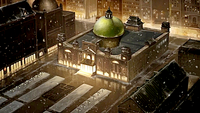
City Hall is one of the oldest and most iconic buildings in the city.
- City Hall - It serves as the seat of the United Republic government.[14]
- Harmony Tower - This tower is a tall structure that overlooks a large portion of Republic City. Its metal support beams arch elegantly upward, making it a unique feat of architecture.[45]
- Kwong's Cuisine - Kwong's Cuisine is restaurant building located near downtown Republic City which features influences from traditional Water Tribe architecture as well as more modern building styles. The building's unique combination of architectural style portrays the melting pot nature of the city itself.[46]
- Kyoshi Bridge - It is one of many bridges that serves as a passage into or out of Republic City.[47]
- Little Ba Sing Se Fashion Mall - Is a building complex built to resemble the Earth Kingdom capital, Ba Sing Se. It is divided into several rings and each ring offers commodities of a different financial class.
- Mako and Bolin's apartment - This is the apartment Mako and Bolin lived in before it was overtaken by spirit vines during the Unalaq Crisis.[47]
- Narook's Seaweed Noodlery - Is a restaurant located in the Little Water Tribe neighborhood of Republic City. It serves authentic Southern Water Tribe cuisine at affordable prices, including seaweed noodles, which are advertised on the radio as the best in the city.[48]
- Police headquarters - It is the base of operations for the Metalbending Police Force, where criminals in Republic City are taken in for custody. The architecture of the police headquarters is comparable to that of standard Earth Kingdom buildings, with both the exterior and the interior being largely geometrical in design.[14]

The Four Elements is a multiple-story building with white bricks and cyan details, built for the city's elite.
- Pro-bending Arena - As the place where pro-bending matches are held in Republic City, this arena is a colossal, glass-domed structure located at the end of a pier extending into Yue Bay.[14]
- Republic City Four Elements - An iconic hotel in Republic City. Sporting a grand lobby and luxurious suites, the hotel is a venue for high-profile guests: Prince Wu, heir to the Earth Kingdom throne, stayed here during his exile from Ba Sing Se (though he was forced out of the best suite by the arrival of Kuvira).
- Silk Road Bridge - Is a suspension bridge located in Republic City.[43]
- Southern Water Tribe Cultural Center - Is a building in downtown Republic City that hosts activities related to the culture of the Southern Water Tribe.
Spirit World[]
List of architectural works[]
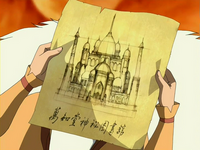
Wan Shi Tong's Library resembles the Taj Mahal.
- Wan Shi Tong's Library - Wan Shi Tong's Library was an immense structure located in the Si Wong Desert. It contained information on everything in the world. However, it was buried during the course of Aang's journey.
- Iroh's tea shop - Iroh's tea shop was created in the Spirit World near Hai-Riyo Peak. Korra visited his teashop during her visit into the Spirit World.
Other[]
- Chou palace - Home of the Chou family during the era of Raava, it resembled a traditional pagoda and was built on the highest point of a fire lion turtle's shell.[49]
Notable architects[]
Trivia[]
- Most buildings throughout the world are notably similar to traditional Chinese structures in the mid-1800s; however, in the United Republic of Nations, there are different styles that have a greater similarity to 1920s Western architecture.
- The style of the air temples is similar to Bhutanese temples and most of them are also primarily built on craggy mountains and foothills.
- In the Northern Water Tribe, the chief's palace draws inspiration from the 'Gopurams' of South-Indian Dravidian style temple architecture.
- In the Southern Water Tribe, the houses draw inspiration from the Inuit-Yupik culture.[50]
- In the Fire Nation, Southeast Asian architecture is the most prominent style seen from the wooden structures of the river village along the Jang Hui River to the red-roofed vacation homes on Ember Island.
- The Sun Warriors' ancient city is based on Mayan and Aztec culture.
- The Beifong family estate bears semblance to the Siheyuan, a form of traditional Chinese walled compound.
- The Earth Kingdom Royal Palace in Ba Sing Se closely resembles the Forbidden City in China.
- Wan Shi Tong's Library closely resembles the Taj Mahal in India.
- Stupas, such as the one Jinora meditated at during her search for Korra, are used throughout the world to indicate areas with strong spiritual energy.[51]